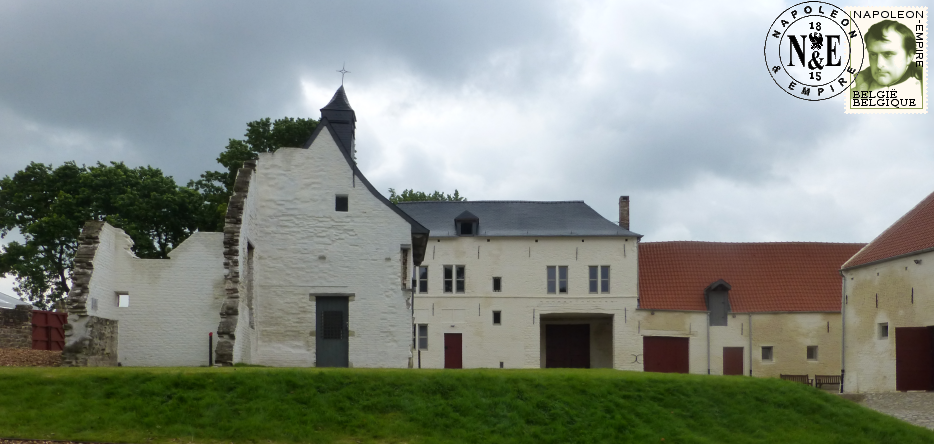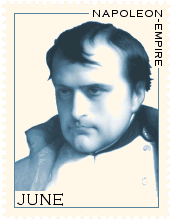The Campaign of 1815 in Belgium
day by day
After taking power on 20 March 1815, upon returning from his exile on the island of Elba, Napoleon I protested his peaceful intentions, but the European powers gathered at the Congress of Vienna refused to recognise the new regime. A military alliance was immediately concluded between England, Russia, Austria and Prussia, soon joined by secondary powers. However, the dispersion of available troops did not make them consider reaching the French borders until the end of July.
Anticipating an inevitable numerical inferiority, Napoleon took the lead and planned a lightning offensive on Belgium (belonging to the United Kingdom of the Netherlands since 15 March 1815), where he would only have to face Prussian and Anglo-Dutch troops.
From the first days of June, the French troops were ordered to concentrate on Avesnes-sur-Helpe, Maubeuge, Rocroi and Chimay (then in the Ardennes department).
The Emperor himself set off on June 12, to join the Army of the North which was waiting for him from the 13th on the Beaumont plateau, on the border with Belgium.
The defeat at Waterloo on 18 June marked the failure of this strategy, and, only ten days after his departure, Napoleon was back in Paris.

During several trips to Belgium, we visited the places where the imperial army passed during this final campaign, in particular the battlefields of Ligny , Quatre-Bras , Wavre and Waterloo . The photos on this page come from these stays.
June 1815

- June 12 - Having left Paris at four in the morning, Napoleon arrived at Laon around noon. He spent the night there.
- June 13 - He was at Avesnes-sur-Helpe and had lunch with Marshal Michel Ney, Prince of Moskowa. The Emperor spent the night in this town of three thousand inhabitants.
- June 14 - After about thirty kilometers in an east-northeast direction, traveled by sedan, Napoleon set up his Headquarters at Beaumont , a border town then in French territory, where he joined the Army of the North, to which he made a proclamation . He also studied a topographical report prepared by Colonel Jean-Baptiste Brousseaud, a geographical engineer, as well as an espionage report, both relating to the communication routes that the imperial army was likely to use during this campaign. Subsequently, he wrote a movement order for the attention of the various corps commanders, concerning the operations of the following morning.
- June 15 - Napoleon crossed the border with the vanguard, crossed the river Sambre and spent the day in Ham-sur-Heure , Charleroi (which he reached around noon) and Gilly, where a fight against Prussian troops took place. Napoleon then returned to sleep in Charleroi.
- June 16 - Napoleon left Charleroi around ten o'clock, and arrived in Fleurus shortly after. There, he observed the enemy positions from the Naveau mill . General Étienne Maurice Gérard informed him of General Bourmont's betrayal. At three o'clock, the Battle of Ligny (sometimes called the "Battle of Fleurus of 1815") began against the Prussians commanded by the Emperor's old enemy, Gebhard von Blücher, who was defeated and had to retreat at dusk.
That same day, Marshal Ney fought, without decisive results however, at a place called Quatre-Bras , against the Anglo-Dutch troops of Arthur Wellesley, Duke of Wellington.
Napoleon then set up his Headquarters in Fleurus, at the Château de la Paix . He slept there , while his troops occupied the farm of the same name , which adjoined the castle.
- June 17 - Napoleon Bonaparte passed through Bussy , Marbais , near Quatre-Bras , then continued north towards Genappe then the Belle-Alliance Farm , which he reached around 6:30 p.m. in very bad weather, and where he suffered a few gunshots. He retraced his steps for 2.7 km to the Caillou Farm , where he set up his Headquarters, held a final council of war , and spent the night .
- June 18 - Early in the morning, Napoleon went to the Chantelet Farm . Then, back at Le Caillou, he set off at the head of his troops towards the north, towards the army of Arthur Wellesley of Wellington, who he knew was waiting for him at Mont-Saint-Jean .
He set up a first observation post on a mound near the Rossomme Farm [now destroyed]. He continued to advance to Belle-Alliance and the house of the guide Jean-Baptiste Decoster . Then began the terrible Battle of Waterloo .
During the operations, the Guard advanced to the Haye-Sainte Farm . But it was defeated in turn, and the Emperor had to retreat via Belle-Alliance, the Decoster house, the Caillou farm and Genappe , where the narrowness of the bridge over the river Dyle forced him to abandon his carriage and continue on horseback .
- June 19 - Unaware of the outcome of the Battle of Waterloo, Marshal Emmanuel de Grouchy defeated the Prussians at Wavre and its surroundings (a battle that had been fought the previous evening).
Napoleon, for his part, continued his retreat through Quatre-Bras , then Charleroi, before reaching Philippeville and Corbineau.
- June 20 - Napoleon passed through Rethel and Berry-au-Bac , and arrived at Laon .
- June 21 - Napoléon was back in Paris after this short but disastrous campaign.
 All of Napoleon's movements from 1769 to 1821
All of Napoleon's movements from 1769 to 1821
Photos credits
Photos by Lionel A. Bouchon.Photos by Didier Grau.
Photos by Michèle Grau-Ghelardi.
Photos by Marie-Albe Grau.
Photos by Floriane Grau.
Photos by various authors.